USS Des Moines CA-134
Reviewed by Timothy Choi
June 2021
| (A VERY BRIEF) HISTORY | |||||||||||||||||
| Equipped with nine automatic 8"/55 Mk 16 guns, the Des Moines class was the epitome of American heavy cruiser design. Laid down at the end of the Second World War and entering service right at the cusp of the missile age, Des Moines and sisters Salem and Newport News would go on to serve throughout the 1950s in the Atlantic and Mediterranean, delivering the threat of rapid-fire naval gunfire support from the sea. With a firing rate three times faster than previous American 8" guns and all-angle loading, one wonders how they may have faired in a ship-on-ship battle. In the earlier years of the Modelwarships.com message board, frequent battles of words were fought over whether the superior radar and firing rate of this class could take on as deadly a foe as the IJN's Yamato...but I digress. Although Des Moines and Salem were mothballed in 1961 and 1959, respectively, Newport News served until 1975, and was the only one of the three sisters to fire her guns in combat when she sailed off Vietnam. Salem remains as a museum ship today (the only 8"-gunned cruiser remaining in the world!) while the other two were scrapped post-Cold War. | |||||||||||||||||
| The
Very Fire USS Des Moines
Very Fire, a relative newcomer from China, has teamed up with Blue Ridge Models once again to produce Des Moines and sister Salem in both 1/350 and 1/700 scales. Released in Fall 2020, a "DX" version for Des Moines in both scales is available that includes all the extra PE, turned brass, resin, and wooden deck goodies. A separate upgrade set for Des Moines also exists if you, like me, ended up with the non-DX version or need to upgrade the Salem (which seems not to have a DX version). The differences between the Des Moines and Salem kit appear to be different AA gun configurations on the main deck, absence/presence of stern catapults/aircraft, and different mainmast. If one cannot find (or willing to pay for) the dedicated upgrade set or a DX kit, all is not lost: the following review should show that one can make a very good model out of the box and/or with only basic PE railings and radars. To shamelessly paraphrase Martin Quinn's review of the same company's 1/350 Missouri, the Des Moines comes in a very sturdy cardboard box. On the box top is a decent painting of Des Moines at sea postwar in overall haze grey. On the sides of the box are either CAD renderings or photos of the completed, unpainted model. Upon opening the box, one notes that it is brimming to the top with content: first the instruction booklet and paint guide, then the stacks of sweet sweet individually-bagged injection molded plastic sprues. Unlike their 1/350 cousins, the 1/700 kit has much less fancy packaging: no additional cardboard inserts, just plastic from boxside to boxside, top to bottom. Decals, PE, and anchor chain are in their own plastic baggies at the very bottom. |
|||||||||||||||||
|
|||||||||||||||||
| HULL PARTS | |||||||||||||||||
| The hull is molded in upper and lower halves, both in grey
plastic. To protect the very fine sharp bow(s), some foam cushioning is
taped on. No separate waterline plate is included, though the bottom of
the upper hull is "plated" to provide you with that extra stability. The
two halves fit excellently, with only a slight "underbite" at the stern
that should be easily sanded smooth. The upper hull in my copy has a slight
bowing amidships, requiring a bit of pressure to hold flat flush with the
lower hull - not a big deal and I expect glue-while-clamp to solve it without
issues. There are some mold seams that will have to be sanded/scraped off,
and the extra-discerning builder might see fit to do some putty work at
the bow of the lower hull where the thicker plastic's longer cooling time
resulted in the typical divot.
In terms of detailing, they appear excellent. The armour belts/plating are rendered well, though perhaps a bit soft at the ends and maybe a bit overscale in thickness. The stem where it enters the water appears adequately sharp, though perhaps a quick swipe of sandpaper might make it even more to-scale. Along the top edge of the upper hull are the various fairleads and chocks, which are very nice though could use some opening up all the way with one's pinvise. The bow mooring chain/cable fairleads are molded fully open, which look very nice. For those concerned about the gap between hull and deck around the anchor hawser cutouts, worry not - parts 1 and 2 on Sprue F is the ring that'll cover it up nicely. In terms of length, the upper hull measures just a bit over 31 cm, which stacks up well with calculated 1/700 overall length of 31.2 cm (full size overall from Navsource shows 716' 6", or 218.39 m). |
|||||||||||||||||
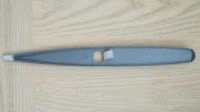 |
|||||||||||||||||
|
|||||||||||||||||
| DECK AND CHAIN | |||||||||||||||||
| The main deck is molded as one large piece, with the aviation
deck a separately molded part on sprue G, covered later in this review.
Like the hull, the tip is wrapped in protective foam.
No anchor chain is molded on, as there is a length of "real" chain included. It is likely overscale, but looks quite good anyway (with plenty of extra length for your other ships). The molded-on detailing is excellent. Hatches have their wheels and dogs included, for example, and there are notable detailing on the bases for the capstans. The main thing I dislike are the butt-ends for the deck planks: I'm one of those who firmly believe they're much too overscale in 1/700, and their prominence can be seen in the wider shots of the deck where they dominate the deck pattern, reminiscent of tie-downs on a carrier deck. One additional negative note is the attempt at rendering a canvas-covered entryway into the decks below on the bow (deck-03.JPG): it shows up as a solid pillar when rendering it as just another hatch for the modeler to make their own PE+white glue awning would be preferred. The fit of the deck into the upper hull is about as perfect as one can expect, though I did not test how the stern piece for the aviation deck fits. |
|||||||||||||||||
 |
|||||||||||||||||
|
|||||||||||||||||
| SUPERSTRUCTURE | |||||||||||||||||
| The last piece that comes on its own is the superstructure. Lovingly detailed through the magic of slide-molding, it even has pipes on the barbettes! The ladder rungs are molded, well, like rungs, rather than simple horizontal lines. The vents at the base of the funnel are also excellently done. The only complaint is the decision to mold the non-skid/slip pads rather than provide them as decals as Dragon did on their 1/700 USN destroyers - at this scale, they'd trip up many a sailor, betraying their non-slip purpose. On the plus side, one doesn't have to deal with decaling! | |||||||||||||||||
 |
|||||||||||||||||
|
|||||||||||||||||
The "first" sprue is E, which contains platforms and decks for the superstructure
and gun tubs. As usual, excellently detailed, including a few bits of bridge
equipment molded on the interior side of the bridge bulkheads. The only
complaint (other than, again, the molded-on non-skid pads) is the decision
to have the sprue nubs be sited on the panes of the bridge windows (e-05.JPG),
which make them somewhat more inconvenient to remove and clean up than
if they were sited on the frames. Of course, that's not a problem if you
replace them with PE window frames/ladders. 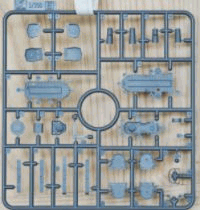
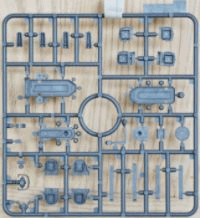 |
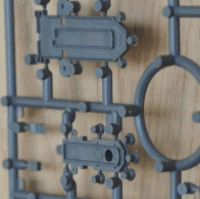 |
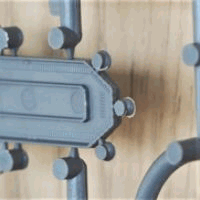 |
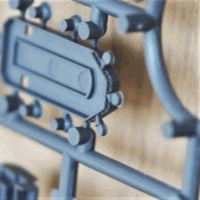 |
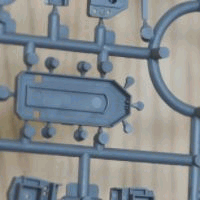 |
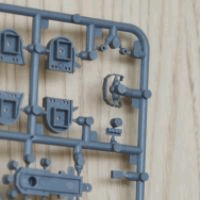 |
Sprue F contains miscellaneous large objects: running gear, masts, funnel,
hangar hatch, stern crane, radars, and platforms. Again, very finely molded
with no criticisms worth mentioning. The crane seems simple enough that
one can simply drill open the holes on both halves and skip the need for
a PE variant. Comments on the radars can be found in the section reviewing
the Photoetched fret near the bottom of this review. 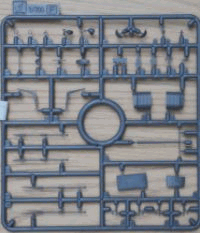
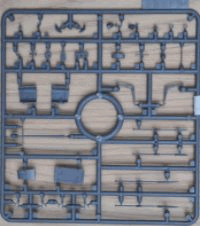 |
Sprue G is the dedicated sprue for Des Moines. Salem replaces it with
Sprue H. It contains the bulwarks for the main deck AA positions, as well
as one of the masts and associated platform. The dominant piece is the
aviation deck. Sadly, there is no provision for an open-hatch seaplane
hangar display: the deck is solid under the hatch position. 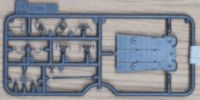
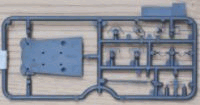 |
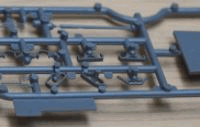 |
Three I sprues are included, containing the ship's weapons: the 8" turrets, the 3"/50 duals, and dual 20mm Oerlikons. Also included are their associated fire control directors, catapults, deck fittings, boat booms, ship's propellers, and other knick-nacks.
Although incredibly well-detailed, the I sprue suffers from two production
issues, one major and one minor. The major one is the broken 8" barrels.
Of the nine total barrels included (3 on each sprue), five of them came
out of the box broken - see the split sections circled in yellow on i-03.JPG.
While this is not an issue if you intended on replacing them with brass
replacements, the plastic barrels themselves are quite fine and would've
satisfied most builders. Additionally, there are currently no brass 8"/55
RF Mk 16 barrels available on their own and it's not certain to this reviewer
the extent to which the plethora of older 8"/55 barrels (particularly Mk
12) can stand in for the Des Moines' signature weapons (photos from oblique
angles indicate they at least share having only one "step" on the barrel).
The second, more minor, issue is the inconsistent molding of the twin 20mm
Oerlikon barrels: some of them are noticeably shorter than others (see
i-09.JPG - the red box ensures the line across the top of the barrels are
parallel to the frame. Note how short the middle two Oerlikon barrel sets
are). Again, not a problem if you were thinking of aftermarket replacements
(or simply cutting them off and replacing with thin wire), and there are
certainly plenty of PE options. But if you want a more 3D appearance, twin
Oerlikons aren't quite as common as their single-mount variants. Options
include Blue
Ridge's and 3D
Modelparts' 3D-printed offerings. In any case, try to find one with
the tripod mounting, rather than pedastal base as what the kit includes,
though the noticeable difference in this scale (especially if not using
PE parts) are minimal. The kit also lacks the shield for the 20mm, so one
might consider procuring aftermarket options anyway and thereby shoot down
multiple birds with one AA gun. 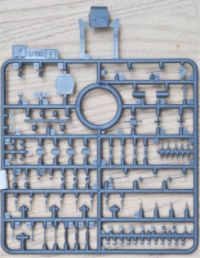
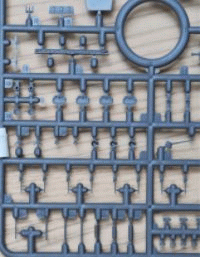 |
 |
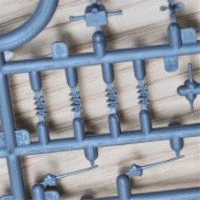 |
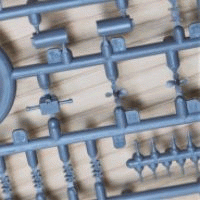 |
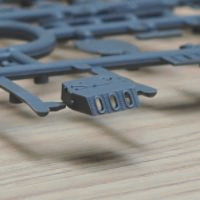 |
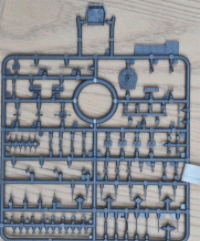 |
 |
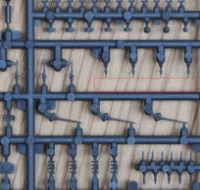 |
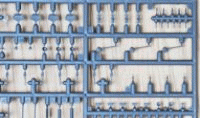 |
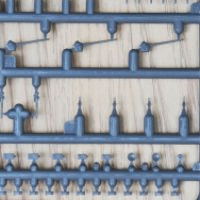 |
Four sprue PA provide you with parts for the 5"/38s and their directors,
other directors, pelori and binnacles, a boat, and the latter's davits.
All are very nicely and, except for the Mk 51 directors, completly molded.
Noteworthy are the planking detail at the bottom of the boat, the tiny
magnetic stones on either sides of the binnacle, and the bolts on the 5"/38
mount hatches. The Mk 51 directors are certainly very detailed, but one
wonders how much of that detailing will keep after one attempts to remove
them from their frame, given the attachment points to the most fragile
"arms" section of those items (i.e. where does the attachment point end
and the part begins). In close-up photography, one can also see inconsistences
between copies of the Mk 51s. Minor issues, however, and the detail level
matches or exceeds most aftermarket options. 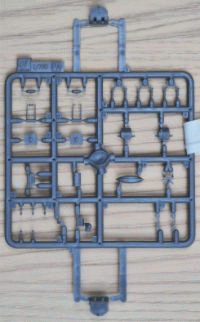
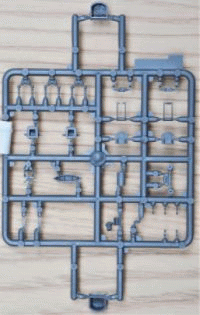 |
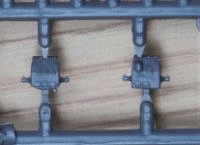 |
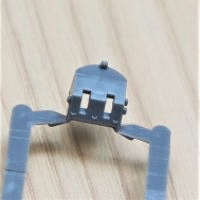 |
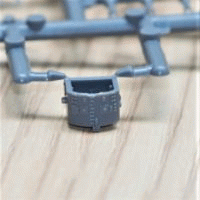 |
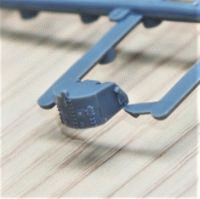 |
 |
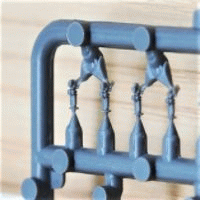 |
 |
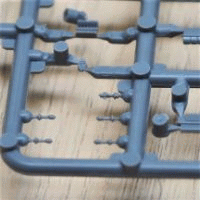 |
|||
Three PC sprues provide single 20mm Oerlikon mountings and their ammunition
boxes. Since the kit does not use the single 20mm, you'd only be using
these exquisite sprues for their rather less exciting ammo boxes. But at
least you'll have some excellent guns for your spares box! 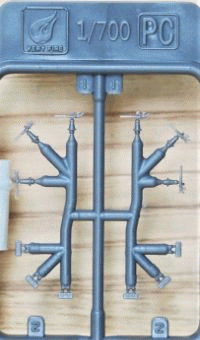
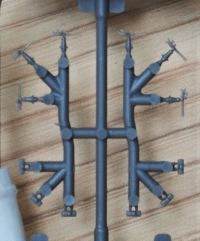 |
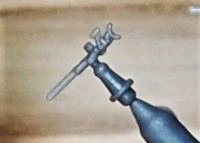 |
 |
Four PD sprues provide a plethora of deck vents and capstans for the
deck. Not too exciting, but again nicely detailed. 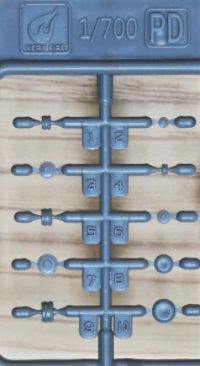
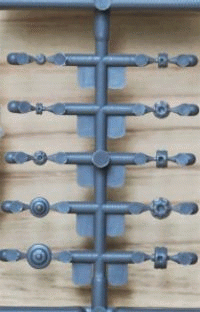 |
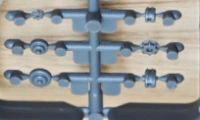 |
Four PF sprues provide deck winches and training guns for the 5"/38s,
as well as paravanes and the "drum" section (part 2) of cable reels. Parts
1, 3, and 4 appear to not be used. 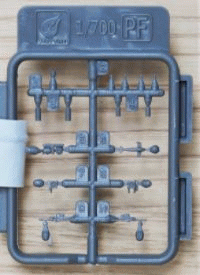
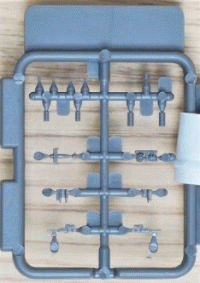 |
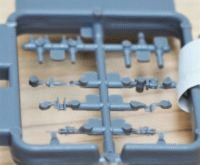 |
 |
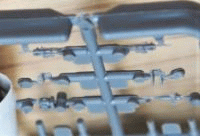 |
Four PG sprues provide binoculars and searchlights. As usual, these
parts are superbly detailed - note especially part 2, with the binoculars
set upon a serpentine mount. 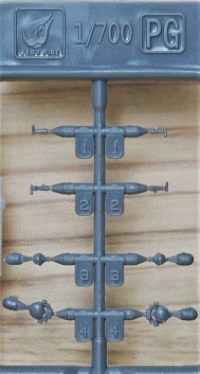
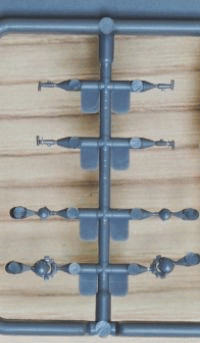 |
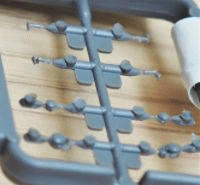 |
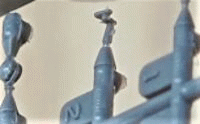 |
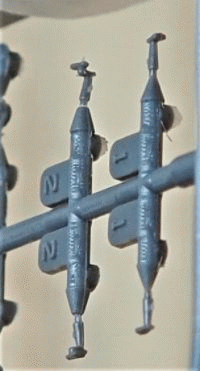 |
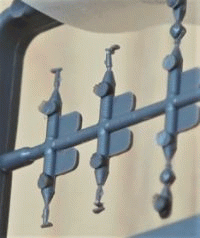 |
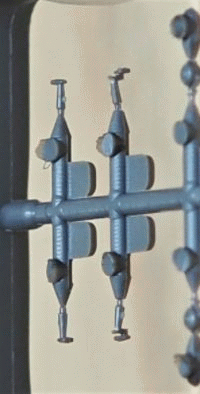 |
Making it clear that this kit depicts Des Moines in her early years,
two PI sprues contain one Curtiss SC Seahawk scout/recon plane each are
included. They are thankfully molded in solid grey rather than in clear
plastic. No plastic prop is included - you're to use the PE one. Radio
antenna "rigging" is also provided for in the PE fret. 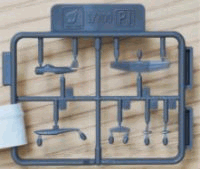
 |
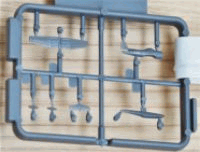 |
A small PE fret is included to cover the following items: radars for the foremast, aerial and prop for the Seahawk aircraft, cable reels, and two hatches. While PE is provided for both the upper SG-6 surface search and lower SR-3 air search radars on the foremast, the kit gives you the option to replace the SR-3 with the SPS-6 that Des Moines received a few years after commissioning, but the SPS-6 is provided only in plastic (see sprue F) despite its mesh structure being in much greater need for PE. No PE parts are included for the fire control radar dishes, which is unfortunate given their relative rarity on the aftermarket market compared to wartime radars. A strange omission are the propeller guards, which are show in the last step of the instructions but are not called out or included in plastic or PE.
(A good illustrated guide to radars of this time period can be found on the unofficial website for the Baltimore class USS Los Angeles, here.)
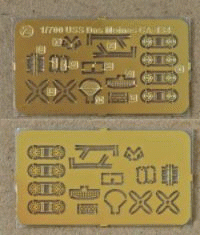 |
DECAL
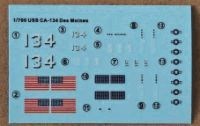 A
decent decal sheet is included for the bow and stern hull numbers, draft
markings, stern name, flags, insignia for the aircraft, and "Battle E"
excellence awards (which are strange inclusions for a kit that only contains
parts for the ship's early years before she would receive those awards).
A
decent decal sheet is included for the bow and stern hull numbers, draft
markings, stern name, flags, insignia for the aircraft, and "Battle E"
excellence awards (which are strange inclusions for a kit that only contains
parts for the ship's early years before she would receive those awards).
INSTRUCTIONS
An eight-page instruction book is included, with good, clear spacing between parts and heavy use of subassemblies. I apologize for the poor quality of the images - the pandemic prevents me from accessing the office and its scanner.
A full color poster showing the painting recommendations for Des Moines
is included. Paint callouts are for Mr. Hobby and Very Fire's own line
of paints.
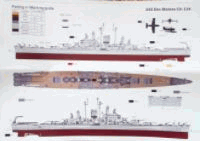
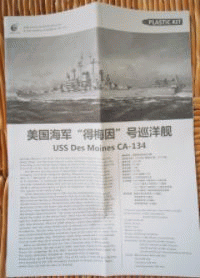 |
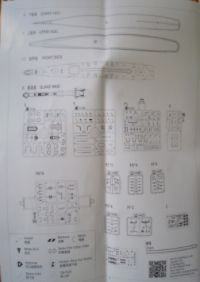 |
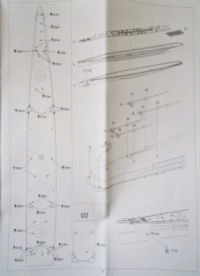 |
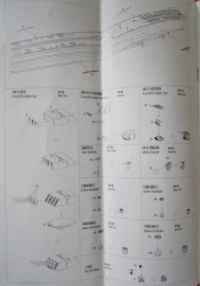 |
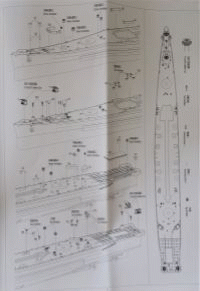 |
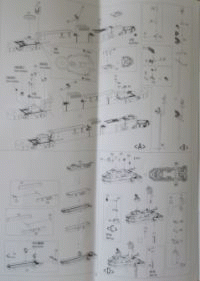 |
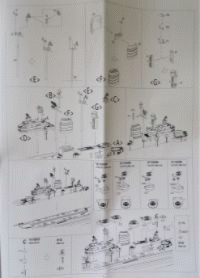 |
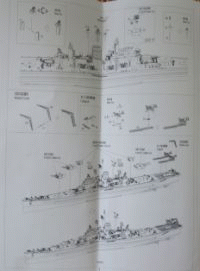 |
The Des Moines class has long been a holy grail for some modelers, but
the class had failed to attract sufficient interest from injection molded
plastic kitmakers, with only a couple of fairly rare resin kits for the
last two decades. This drought has now ended, with Very Fire willing to
take the risk of producing top-class kits of these "mini Iowas". With detail
levels well within the top tier of current injection molded plastic kits,
there is certainly much to admire in Very Fire's kits. Their relative inexperience
shows, however, with the damaged/short-shotted moldings in some of the
parts and questionable placements of sprue attachment points. Greater attention
will have to be paid on the manufacturing and, potentially, packaging sides
if Very Fire wants to become a "trusted name" in the industry. Nonetheless,
with some hunting around for aftermarket 8" barrels and twin Oerlikons,
all signs suggest the Des Moines kit will build up into a highly detailed
and faithful replica of the lead ship of the US Navy's last class of heavy
cruiser with a minimum of fuss. The heavy use of slidemolding minimizes
gaps on the superstructure and turrets, making for a relatively straightforward
(by today's standards) model, while the excellent fit between main deck
and hull halves promise a well-fitting experience for the rest of the plastic.

Verdict: recommended, with above caveats, though one does not exactly
have alternative options for the class. Ten, or even five, years ago, I
would likely have been much more effusive in my praise of the kit, but
with so many new brands and products coming out these days (who says the
hobby is dying?), we're a bit spoiled for expectations if not yet in subject
choice. It would be interesting to see how all the extra goodies in the
DX version might improve upon the already excellently-detailed base kit.
If one does not wish to look for or cannot find the DX version, some recommended
generic upgrades include railings, Cold War USN radars, twin 20mm Oerlikons,
and 8" brass barrels, though buying all those new would almost certainly
bring the overall cost up to that of the DX version so I would recommend
only doing so if one already has some or all of such items in their spares.
Thanks to Very Fire for this review copy of 1/700 USS Des Moines CA-134, product code VF700907. It retails for between $35-$45 USD as of June 2021 from our sponsors, depending on where in the world they're located. This puts them solidly within the same price range of more well-established brands' kits in spite of the higher level of detailing, offering great value for the modeler.
